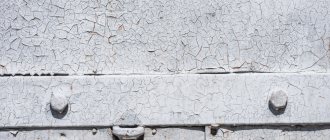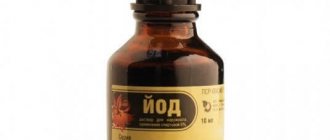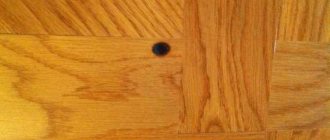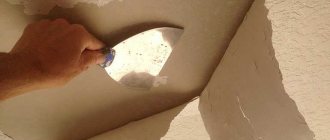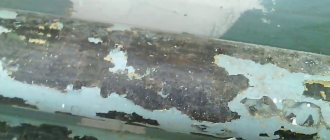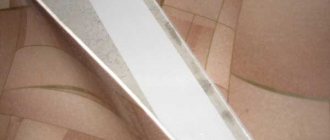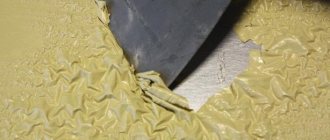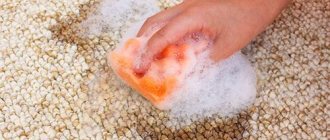Types of paints
Oil paint. Oil-based paint compositions have excellent adhesion and increased durability. Among all paint and varnish compositions, oil-based ones adhere to the surface much more effectively.
Oil-based paint compositions have excellent adhesion and increased durability.
Linoleum coating is easily processed with this composition, is a quick-drying product and has low toxicity.
Butyl rubber and chlorinated rubber enamels. This type of paint creates a durable yet soft coating, but the work will require special surface preparation. In addition, grease and oil stains may remain on the enamel. The complete drying period is 24-30 hours, the paint belongs to the budget price category.
This type of paint creates a durable yet soft coating.
Alkyd, polyurethane and alkyd-urethane compositions. This type of coloring compositions is a high-quality and expensive product. The coating is highly durable and hard.
This type of coloring compositions is a high-quality and expensive product.
Acrylic paints and varnishes. Using acrylic paint you can make the coating tough and durable; it is excellent for commercial linoleum.
Using acrylic paint you can make the coating tough and durable.
In the process of updating the linoleum covering, you may encounter the problem of accidental staining or contamination of areas that should not be painted
It is important to remove the paint so as not to damage the material. Any stain can be wiped off with a napkin or a clean cloth, but only if this is done immediately; if the contamination was not removed in a timely manner, then the dried paint will have to be removed in other ways
We invite you to read: Decorate the garden with your own hands from scrap materials
Cleaning methods:
- Mechanical method. Stains are removed with abrasives;
- Chemical substances. Special chemical compounds are used.
The most suitable cleaning chemicals are:
- Acetone;
- White Spirit;
- Special composition for removing construction paints and varnishes.
Acetone is one of the most effective and at the same time most dangerous substances.
Coloring rules
Coating of products with coloring compounds is carried out according to certain rules:
- The parts must be well dried according to the manufacturing technology.
- After purchase, the elements must be aged at home. It takes at least 1–2 days for the stone to reach a balance of temperature and humidity.
- If previously treated products are painted, they are pre-polished. This is very difficult to do, especially when the products are already on the walls.
- Impregnations are used according to the recommendations that each manufacturer indicates on the label. Some are applied before painting, others after. Some options are not compatible with coloring compounds.
Possible problems and advice from experts
First of all, it is necessary to follow the varnishing scheme. The first layer is applied by moving the roller parallel to the plane of the window opening. Next, we wait until it dries and lay the second, finishing layer, this time rolling out the liquid with a roller perpendicular to the plane of the window opening.
Important! Regardless of the number of layers, the finishing installation of the varnish composition is carried out in a direction perpendicular to the plane of the window. Only in this case will it be possible to avoid streaks and tool marks on the surface.
It is necessary to dry linoleum with the windows and doors closed, no heating devices, otherwise the surface will be covered with dust and instead of gloss there will be a gray spotted mass. If you dry the coating too quickly, cracks will definitely appear.
Furniture can be brought into the room no earlier than after 5-7 days, depending on the temperature and humidity.
How to paint linoleum at home
First of all, you need to follow the sequence of work. This means you immediately need to prepare the surface for painting. Only after this we will apply paint. It also doesn’t hurt to stock up on the necessary supplies in advance. So as not to run to the store during the dyeing process. And remember, there should be no swelling or waves on the linoleum.
To paint linoleum you need the following tool:
- Bucket of water, detergent, rag and mop. Remember to paint on a clean surface;
- Accessories for repairing old linoleum. In case of holes and tears;
- Medium grit sandpaper. For treating the top coat layer to improve adhesion;
- Primer and varnish, in case of using acrylic paints;
- Select and buy paint for linoleum based on the above requirements;
- A special tray or tray for paint. This will make it more convenient to paint;
- Paint roller to ensure even distribution of paint. Don't forget to buy a brush too. It is useful for hard-to-reach places;
- Painting tape to cover the baseboard without removing it.
Step-by-step instruction
Now let’s figure out how to properly paint linoleum with your own hands. I advise you to decide on the color in advance. This can be a monochromatic design, a 2-color striped pattern, or the use of a beautiful stencil. After choosing the shades, we begin the work. Read these step-by-step instructions carefully.
The first step in preparing the linoleum surface is cleaning it. If it's a kitchen, there will be a lot of dirty, greasy stains on the floor. It is necessary to wipe them off so that the paint lays evenly and adheres well. There are also a lot of stains, stains and debris in the toilet and bathroom. Fairy is good for cleaning floors.
The second step is to thoroughly inspect the floor for tears and damage. It is imperative to repair holes in the linoleum. This will make the new floor look nice and prevent the paint from peeling. For repairs you will need a patch, cold welding (best) or liquid nails and double-sided tape.
The third stage is treating the linoleum surface with sandpaper. As already mentioned, medium-grit sandpaper is sufficient. There is no need to rub hard and completely remove the top layer. It is enough to lightly walk over the entire surface of the floor. This will allow you to remove solid debris and sand. The surface will become slightly rough, which will significantly improve adhesion to the paint.
Step No. 4 - if you use acrylic paints, be sure to prime and degrease the surface after sanding. This way the paint will adhere better and more evenly to the surface.
Fifth stage – we paste masking tape over the baseboard so as not to stain it with paint. You can remove your baseboards and not have to deal with tape. In general, do what is most convenient for you.
Step six - you can start painting the linoleum. To reliably paint over the old pattern, it is better to apply 2 layers of paint alternately. This means we apply the second layer only after the first has completely dried. This way we will completely eliminate the possibility of the pattern showing through.
Important! If you are planning a two-tone striped floor, after applying 2 coats of the first "base" color, wait for it to dry. Next, cover the surface with strips of tape at the required width from each other.
For accuracy, it is better to measure this width in advance so that it is the same. Then feel free to apply paint between the strips of adhesive tape. When the floor is dry, carefully remove the tape. The result will be a beautiful, uniform and clear pattern.
In the case of a stencil, it is better to use a square shape. This will make it easier for you to apply a pattern to the surface of the linoleum.
Well, then we wait for the paint to dry
Pay attention to the complete drying time, it is indicated on the can. Only after this can furniture be brought in so as not to spoil the surface
The last step is when using acrylic paints, after drying, the surface is covered with one or two layers of varnish. Be sure to do this so that the paint does not peel off later. A regular varnish based on the same acrylic is suitable.
Don't be afraid to paint old linoleum a different color. Painting actually doesn't take that long. Start your work in the morning and use quick-drying paint. This will allow you to complete the coloring by the end of the day. Sometimes, depending on the type of paint, you need to wait a few more days. This is necessary for the surface to acquire final strength.
Surface preparation
In order for the updated linoleum to please the eye for a long time, and the paint not to crack or scrape off over time, you first need to treat the flooring material well. The task is to remove all factory wax from the surface and clean it from dirt and dust. Unlike preliminary manipulations with laminate or oiled wooden parquet, this is much easier and faster to do.
Before painting, you must carefully prepare the linoleum
Surface preparation before painting occurs in the following order:
- Clean the surface. Not only from dirt and oily stains, but also from wax. To clean the wax, add a glass of soda to a bucket of hot water and wash the floor with this calcined solution. To achieve the best effect, use a brush.
- Wash the floor with water without leaving any streaks. Dry.
- Check for cracks and peeling of linoleum. If there is, then seal it with putty. Seal any loose joints with acrylic sealant.
- Prime the surface. As a primer, use either a regular primer or varnish. Painting can be done without this step, but this way the paint will lie smoother and adhere better to the linoleum.
After the primed surface has dried, you should begin painting the linoleum.
Unusual coloring of a plaster product
There are ways to paint plaster with your own hands, which allow you to achieve an interesting look for the surface, including aging.
Under old marble
Process algorithm:
When making it yourself, the stone is thoroughly dried; the temperature should not exceed 55 degrees at the last stage of drying. The purchased product is aged for 48 hours in a warm room. Next, heat the drying oil
You must be careful and wear gloves when working. A flute brush is used for application. The surface is impregnated in two layers, all areas are treated with special care to avoid gaps. Over time, the elements will take on a look reminiscent of old marble.
In addition, such impregnation reduces the hygroscopicity of gypsum.
Under terracotta
The technology is almost identical to the previous version, but the coating composition is shellac varnish and rosin, which are diluted in industrial alcohol.
After a certain period of time after applying the composition, the surface becomes similar to terracotta.
A mixture of shellac varnish and rosin produces brown plaster.
Creating a bronze sheen
The technology requires the availability of the necessary ingredients and the following steps:
- Plaster figures are well soaked in drying oil and laid to dry for 8–10 hours.
- Bronze powder is prepared, diluted in varnish. Products are treated with this composition in two layers.
- The material dries well.
- A mixture of silver nitrate, acetic acid and water is prepared. Proportions: 10 g of silver, 100 g of vinegar and 300 g of clean water. If required, pigment is added.
- The product is coated with a thin layer of bronze powder and treated with a solution on top. Oxidation occurs.
- The surface is wiped well with a piece of velvet.
Using stain
Stain is used quite often. It can be applied well with a spray gun, but the best results are obtained when completely immersed. To do this, the composition is slightly heated, the parts are dipped for a short time (5 to 10 seconds) and immediately sent to dry. If required, the fragments are pre-wiped.
It might be useful to read:
- Mass specialized E-Mail mailing service;
- Leaders in protection against ddos attacks;
- How to connect to open ports How to connect to open ports;
- How to connect to open ports? ;
- What Windows services can be disabled to speed up the system;
- Installing Kali as an additional operating system on a Windows computer;
- Unity Web Player: what is it for and how to use it? ;
- Department to the police department. Structure of the Ministry of Internal Affairs of Russia. Structure of departments of the Ministry of Internal Affairs. System elements of the Main Directorates;
Paint for linoleum: updating the floor covering the old fashioned way, but with modern means - Floor School
There is an opinion that painting linoleum is not a very good idea: the paint does not adhere well, lays down in an uneven layer, etc. In fact, oil paint (meaning ordinary floor paint) adheres to this coating much better than on a plank floor.
High quality floor paint from
What paints can be used when working with linoleum
Alkyd enamel from Macrofab is a fairly popular material on the Russian market.
This type of paint is successfully used for painting metal and wooden surfaces; therefore, it is perfect for outdated, discolored linoleum.
- Alkyd enamel resists moisture well, as well as exposure to light;
- The paint is universal, durable, and ideal for painting metal and wood surfaces:
- stairs,
- fencing,
- frames.
The Macrofob assortment includes alkyd enamels of the following models:
- ML-1110;
- AS-182;
- ML-165;
- PF-133;
- PF-115;
- MS-160;
- MS-17 and others.
).
Alkyd enamel
Alkyd enamel from Macrofab is a fairly popular material on the Russian market.
This type of paint is successfully used for painting metal and wooden surfaces; therefore, it is perfect for outdated, discolored linoleum.
- Alkyd enamel resists moisture well, as well as exposure to light;
- The paint is universal, durable, and ideal for painting metal and wood surfaces:
- stairs,
- fencing,
- frames.
The Macrofob assortment includes alkyd enamels of the following models:
- ML-1110;
- AS-182;
- ML-165;
- PF-133;
- PF-115;
- MS-160;
- MS-17 and others.
Cleaning linoleum from excess paint
So, when we figured out whether linoleum can be painted, we need to talk about the rules of painting that relate directly to its application
The problem is that when applying the substances described above, the floor may be contaminated due to carelessness. We will talk about how not to damage the coating and eliminate defects that arose during the application of paints and varnishes.
Any blot should be quickly wiped off using a napkin or a regular clean rag. If this action was not performed on time, then the dried stain must be removed in a more complex way.
There are two main cleaning methods:
- Mechanically, the stain can be removed by using abrasives (mixtures containing hard particles), which will help scrub the stain off the surface.
- The chemicals will easily dissolve the active ingredients of the paint and varnish material, and then the residue can be easily wiped off.
Mechanical removal is more practical, since chemicals carry the risk of damaging the linoleum or the protective layer on its surface. It is quite possible that after chemical cleaning there will be no stain, but some part of the coating will be irretrievably lost.
The following chemicals are used as cleaning agents:
- White Spirit;
- acetone;
- Construction varnish remover.
Acetone is considered the most effective on this list, but the increased causticity of the substance makes its use not the safest for coating, so you should exercise extreme caution when applying it to the stain and surrounding area. When rubbing a contaminated area, you must apply a minimum of effort so as not to create a defective area yourself.
Cleaning the stain may be more effective if the stain is treated with vegetable oil. Just 2-3 such applications and attempts at mechanical scrubbing may be more reliable than using harmful chemicals.
Thus, before starting work, it is worth finding out not only whether it is possible to paint linoleum and with what paint, but also to familiarize yourself with the basic rules for applying the substance and the features of cleaning the coating from accidental contaminants, so that during visual inspection and in the photo the floors will be beautiful.
Bottom line
From all of the above, it is not difficult to understand whether it is possible to paint linoleum - the professional’s answer indicates the admissibility of such a procedure. As soon as a high-quality paint and varnish material is selected, it is necessary to paint according to the rules given above, and then the quality will be guaranteed. Renewed linoleum will last for many years, regardless of how many years before painting it was laid.
Types of paints for linoleum Alkyd enamel Acrylic enamels Heat-resistant paints and varnishes Preparing linoleum Cleaning linoleum from excess paint
There is a widespread stereotypical opinion among homeowners that painting linoleum is useless and unreasonable: there is no adhesion of paints and varnishes, there is no uniformity of application, etc. However, as practice shows, this is not the case, and the article will discuss how to choose the right paint and apply it effectively.
What product to cover linoleum - recommendations for choosing
Everything will come down to the issue of acceptable costs, and the specific decision on what varnish composition to cover the linoleum with will depend on the quality of the coating and the associated costs for reinstalling the materials. for comparison, a can of high-quality varnish composition, which can cover the floor of a room of 18 to 20 square meters, costs at least 2,500 rubles, while replacing linoleum of the same area will cost a couple of times more. Naturally, the best option would be the water-based varnish V33 Vitrificateur Renovation.
Reviews about varnish and the varnish coating procedure only confirm the high quality of the materials:
- The gloss is durable and stable.
- Has no aroma.
- No pre-rinsing required.
The manufacturer states that the varnish composition is made on a urethane-alkyd basis in a gel consistency. On the one hand, this will ensure high elasticity of the varnish layer on the linoleum, on the other hand, the absence of “bald” areas and puddles, as often happens when trying to restore the coating of linoleum in bulk.
Please note that varnishing linoleum is extremely important. It is made on the basis of an alkyd-urethane mixture, and therefore the layer has an excellent degree of adhesion, lays down without stains or bubbles, and then retains a degree of elasticity.
Inexpensive option
If you just need to prepare an apartment or room for rent or sale, you can use any acrylic-based parquet-type varnish. Washing and applying varnish to the surface of linoleum will cost from 1100 to 1400 rubles, but the gloss will last for a maximum of a couple of months of use. The advantages of this solution are the convenience of the process and the ability to restore the glossy layer in a day. The disadvantages include a limited number of cycles, and because of this, that the old coating must be removed with sandpaper, approximately at the fifth restoration the surface will completely fail, and will also become covered with deep scratches and cannot be repaired.
Unusual option
Yacht varnishes can be considered the most durable, but they are not so good for linoleum. Due to the high degree of viscosity there is a high risk of staining. In addition, linoleum flooring, as in the previous case, requires preparation, washing and priming. Such varnish compositions darken the floor surface and create a barely noticeable, low gloss. If you correctly apply barrier layers of an excellent primer, and dilute the varnish composition itself and lay it on the linoleum, in at least 2 thin layers, then the durability of such repairs can exceed the French V33.
How to paint linoleum with varnish + step-by-step instructions
First of all, it is important to remove all pieces of furniture from the room and remove the baseboards if their fixation makes it possible to dismantle them. To work you need to stock up:
- Primer and varnish composition.
- Vacuum cleaner, container for varnish and water.
- A couple of paint rollers.
- Paper napkins and clean rags.
- Waterproof sandpaper.
To wash off the old varnish composition, a solvent is needed. You can use an expensive option from the V33 product series, but for parquet varnish it is possible to make do with cheaper material, for example, simple white spirit.
Sanding and washing linoleum surface
In advance, the linoleum needs to be thoroughly washed, to remove the maximum amount of house dust and contaminants that inevitably appear on the coating during the operational process. The next step will be to level and sand the old varnish. It needs to be removed so that the new layer of varnish evenly adheres to the surface of the linoleum without stains. The material should be sanded with fine sandpaper, which is glued to the base of the plaster board. On average, it will take from 1 to 1.5 hours of working time to prepare old material for applying a varnish base in a room with an area of 20 square meters. Next, you need to vacuum and wash the surface of the sanded linoleum with a detergent until it shines. The floor covering needs to be dried for several hours, and then wiped with a dry cloth soaked in white spirit. This will take 30 minutes, and you need to work extremely quickly so as not to inhale fumes from the solvent.
Application of primer
To coat old linoleum with varnish, you need to prepare. In about an hour with the windows open, the material will dry, and you can apply a primer under the varnish; you can use all acrylic primers, preferably not of low quality. Acrylic dries in about an hour, and for linoleum with an area of 18 to 20 square meters you need from 1.5 to 1.8 liters of primer.
Applying a varnish layer
Regardless of which varnish is chosen to restore the linoleum surface, the composition must be applied 2 times. The thinner the layer, the higher the strength and quality of the coating. It is best to apply the materials using a new paint roller or air sprayer if you plan to use alkyl urethane or marine varnish. In the latter case, the number of layers must be increased to 4, but the uniformity and strength of the new coating will be ideal.
Possible problems and recommendations from experts
First of all, it is necessary to follow the varnishing scheme, and the first layer is applied by moving the roller parallel to the plane of the window opening. Next, you need to wait for it to dry and lay the second, final layer, this time rolling out the liquid with a roller perpendicular to the plane of the window opening.
Please note that regardless of the number of layers, the finishing installation of the varnish composition must be carried out in a direction that is perpendicular to the window plane. Only in this case will it be possible to avoid stains and marks from tools on surfaces.
It is important to dry linoleum with doors and windows closed, no heating devices, otherwise the surface will be covered with dust and instead of gloss there will be a spotted gray mass. If you dry the coating very quickly, cracks will definitely appear. pieces of furniture can be brought into the room no earlier than 7 days later, depending on air humidity and temperatures.
How to achieve shine without varnish
Quite often, varnishing alone is not enough to keep the floor covering in good condition. For repaired linoleum flooring, you can apply additional treatment with wax or mastic polish, traditionally used for parquet and laminate floors. For new and fresh linoleum, it would not make sense to polish the surface with mastic, and the outer layer is very soft and does not hold the wax composition very well.
It’s a different matter if there is a very thick layer of varnish on the surface, in which case treatment with polish adds shine and hides flaws. It is usually a water-type suspension that contains microscopic particles of wax material. It is applied in the same way as the varnish composition - in two directions, which are perpendicular to each other. After the mixture has dried, the layer must be treated with an electric or hand polisher, which will give that same gloss.
Features of paint selection
In fact, the question of whether it is possible to paint old linoleum is most relevant for country houses, various summer kitchens and other similar buildings. There, as you know, temperature differences are quite significant, and the load on the surface is high, since people most often walk on it wearing shoes. The strength of the surface is very important, so the paint must be of very high quality.
Oil formulations
Budget option will save money
A few decades ago this was the only possible composition option.
This group of products is characterized by the following features:
- Low price of paint. Even though the cost has risen significantly in recent years, this option remains the most budget-friendly.
- Good adhesion of the composition to the surface. Organic-based linoleum paint adheres well and transforms the surface.
But there are many more disadvantages:
- A rather pungent odor that lasts in the room for several days. Naturally, it is undesirable to be in it during this period.
- The surface drying time is at least a day, while modern options dry in a few hours.
- Poor abrasion resistance, as a result of which the surface must be tinted at least once a year.
Alkyd-based solutions
It is best to choose special enamel for the floor - it has higher abrasion resistance characteristics
You can often come across the question, is it possible to paint linoleum with nitro paint? Due to the high properties of the composition, this type of work is not only possible, but also preferable to oil solutions. After all, paints are made using more advanced and durable polymer solvents, which make the coating more durable.
The main advantages include the following:
- A very wide range of colors, allowing you to choose the best option for any floor. The colors are very rich and vibrant, and thanks to the use of high-quality components, they remain bright for many years.
- The resulting coating is highly resistant to moisture, so alkyd paints can be used in kitchens and bathrooms.
Among the disadvantages, it is worth highlighting a rather pungent odor and low ductility of the paint layer: if the linoleum is soft, then the surface may crack.
Acrylic paints
Very high quality paint for a wide variety of substrates
Let's figure out whether it is possible to paint linoleum with paint based on acrylic polymers. This group of compounds is characterized by high reliability and good adhesion to most materials. Linoleum is no exception, so you can paint it with acrylic paint.
The main advantages of acrylic compositions are as follows:
- High strength and wear resistance of the surface. The coating retains its properties for many years.
- Excellent surface resistance to aggressive chemical influences.
- There is virtually no smell during the work. In addition, the paint is easily washed off with water, which is also an undoubted advantage.
- The drying time of the floor is only a few hours, which allows repairs to be carried out quickly without leaving the premises.
The only downside is the high price of the composition.
Other coating options
There are other options that are used much less frequently than those described above, although with their help you can create a very durable protective layer with your own hands:
Jobi's ultra-durable glossy paint allows you to create a durable coating that is resistant to abrasion, damage and aggressive chemicals. The instructions for using the composition are very simple, and the results are excellent. But the cost of this option is far from budget.
The coating is so durable that it is called “liquid plastic”
If you don’t know how to paint linoleum in a corridor, hallway or other damp room, you can use chlorinated rubber enamel. This composition is so durable that it is even suitable for swimming pools and terraces.
Chlorinated rubber composition has the highest protective properties
Choosing paint and tools
We have determined what material we will have to work with. Now it’s time for the coloring composition. Which paint is most suitable for painting linoleum? The most common types of paints for painting linoleum are oil, alkyd and acrylic. A little more about each of them.
- Oil paint is a budget option and quite outdated compared to today's advanced technologies. It has good adhesion (adhesion) and lies flat on the surface. However, there are also disadvantages: a strong smell, both during painting and for a long time after, it takes quite a long time to dry, about a day, as opposed to modern paints, and it also wears off quickly, so it requires periodic updating. Although oil paint is one of the painting options, if possible it is worth choosing other, modern types of painting solutions, even if they are a little more expensive.
- Alkyd paint is much more advanced than oil paint. Its base is alkyd varnish. It has high elasticity, durability and resistance to water, light and temperature changes. This paint dries within a few hours, which makes painting linoleum easier. It perfectly retains color for a long period of time, and the colors themselves are not only varied, but also rich. One of the disadvantages: when painting it also has a strong odor. But, nevertheless, alkyd paint is more suitable for linoleum, more resistant to mechanical damage and abrasion.
- Acrylic paint is a good option for painting linoleum. Reliable in use, with high adhesion to many surfaces and abrasion resistance, so it will last for many years. In addition, the paint resists chemicals well.
Acrylic paint - fits well on linoleum and increases its service life.
Of all the paints listed, acrylic paints are perhaps the most practical. So they are perfect for linoleum not only in rooms, but also in the kitchen. The paint is easily washed off with water if you accidentally paint another piece of furniture, it does not smell during the process, and dries within a few hours. Conclusion: this is a quality paint that is worth the money.
Of course, there are other mixtures that can be used for painting linoleum, but they are used less frequently due to the unjustified nature of the idea (high consumption and significant price). An example of such paint is chlorinated rubber enamel.
The standard tools for any painting job are a roller or a brush. Together with them you need to buy or get them from the balcony:
- a tray or tray for diluting paint;
- bucket with water;
- clean rags;
- brush;
- soda;
- sealant or putty;
- masking tape;
- primer or varnish;
- gloves and mask.
How to paint linoleum flooring to make it last longer?
With the help of painting, you can not only update the linoleum coating, but also hide minor defects that appeared on it during operation. If you paint a linoleum-covered floor a different color, the room will sparkle with new colors. The main thing when working is to properly prepare the work surface, choose a paint composition suitable for this type of coating and follow the rules for its use.
Preparation: repair, cleaning, sanding, priming
Preparation is the most important stage of painting linoleum. The result of the work depends on how thoroughly the work surface is prepared. Ignoring this step will result in the paint not adhering well, drying unevenly, and peeling off quickly.
The preparatory stage includes the following operations:
- Cleaning the floor from dust and dirt.
- Removing protective wax. It is better to do this with a solution prepared from warm water and a glass of soda. It is more convenient to clean off the protective layer with a brush. After this, the floor covering must be thoroughly dried.
- Elimination of minor defects in the form of cracks and cuts. They can be treated with a thin layer of putty. Broken joints must be sealed with acrylic sealant.
- Sanding. The procedure must be performed with medium-grain sandpaper. You don't have to use a lot of force, just lightly walk over the entire work surface.
- Primer. After the putty has completely dried, the working surface must be primed with an acrylic primer. Varnish can be used as a primer.
Paint selection
To paint linoleum, you can take:
- Alkyd paint. It has a high-quality composition and a wide color palette, it dries quickly, is easy to use, and forms a coating that is resistant to mechanical stress, ultraviolet radiation, moisture and sudden temperature changes. The main disadvantage of this coloring agent is its pungent odor.
- Acrylic paint. This is one of the most durable paint and varnish materials. It adheres perfectly to the surface being painted, increasing its resistance to abrasion. This composition is easy to apply, does not emit toxic substances and dries quickly.
- Oil paint. If you have a limited budget, this option is the most preferable. This paint and varnish adheres well to the prepared surface, applies evenly, and when used correctly does not leave streaks. At the same time, oil paint has many disadvantages: it takes a long time to dry, has a strong, persistent odor, and peels off quickly.
- Heat-resistant paint. Allows you to give the linoleum coating heat resistance. It is better to paint the floor in the kitchen or bathroom with this composition.
The shade of the paint is also important. It should be in harmony with the interior of the room
It should also be taken into account that one of the most frequently soiled surfaces in the house is being painted. It is not recommended to paint it white or other light shades.
What tools are needed?
To work you will need the following tools:
- paint roller with a long handle;
- brush for painting hard-to-reach places;
- masking tape to protect baseboards from accidental paint if there is no desire or opportunity to remove them;
- tray or tray for paint and varnish;
- rubber gloves to protect hands from paint;
- a respirator to prevent poisoning by vapors of the coloring composition;
- an old robe or apron.
Painting linoleum
To paint old linoleum flooring, you need:
- Cover baseboards and wall-to-floor joints with masking tape.
- Pour the coloring composition into the tray and, if required by the manufacturer, dilute it with a solvent. Mix the components thoroughly.
- Paint the surface. Start work from the corner farthest from the door. The paint must be applied in an even layer. Cover the surface in one approach. You should not paint the floor in parts, otherwise transitions will be visible on it.
- Apply a second coat if required. Subsequent layers are applied only after the previous ones have completely dried.
- Cover the work surface with varnish. You can varnish in one or two layers. This prevents the paint from peeling off.
How to paint linoleum
Is it possible to paint PVC roll coating and will it not lose its properties? It is not difficult to apply a new shade and even an image to this material.
Interesting! At the beginning of the 20th century, artists used it as a basis for oil paintings or linocuts.
self-portrait of I. Repin, linoleum, oil.
1920 Linoleum was used as a floor covering 200 years ago. Until the mid-1950s, it was made from a mixture of vegetable oils and other natural ingredients. Now this option is very expensive and is becoming an element of designer interiors.
Read more in the article "What is marmoleum and how to lay it"
During renovations in apartments, synthetic material made from polyvinyl chloride is used. It is durable, resistant to abrasion, and is not harmed by aggressive detergents. The price of PVC linoleum depends on its class and the thickness of the protective layer, but in general it is the cheapest floor covering. Proper painting can significantly extend its service life and change the entire appearance of the apartment. This approach reduces costs on materials and on hiring a specialist, because you can apply enamel or varnish yourself.
result of painting linoleum
Requirements for paints and varnishes
Not every paint is suitable for linoleum, since it has a smooth surface. The composition must have high adhesion, create a durable surface layer that is not washed off with water and household chemicals.
Important! You can improve adhesion by applying a primer, and an additional layer of varnish will provide protection against detergents.
In a living room, you should not apply compositions that take a long time to dry and contain toxic solvents. Caustic components can not only harm your health, but also damage the top layer of PVC, which will damage the coating and have to be replaced.
Types of paints
There are many options in stores for smooth substrates that meet these requirements. Below are their characteristics and recommendations for application.
Oil paints
They are cheap, adhere well to the surface and create a thin layer without streaks. Synthetic or organic fats, which serve as solvents, polymerize slowly at room temperature. It dries up to 24 hours, but even after that the surface will have a strong and unpleasant smell . Due to its high adhesion, such a coating is difficult to wash off completely. But you can accidentally damage the furniture or wipe it with an alkali-containing detergent. You will also need to re-paint it with a composition based on drying oil. If you want to urgently update your interior and spend a minimum of money, oil-based pigments are a good choice. But if the renovation is being done for yourself and is intended to last for a long time, consider other options.
oil paint for interior work
Alkyd paints
Compositions based on synthetic resins provide a durable, shiny film that is resistant to household chemicals. Bright colors with a glossy effect can transform an apartment, completely changing its appearance. Alkyd enamel has high adhesion. Applied in two layers over the primer, it forms a durable coating that is impervious to water and retains its properties for up to 4 years. The price of the composition is low. The main disadvantage is a strong pungent odor that remains in the room for a long time, and potentially dangerous synthetic components . You should also not use it on thick linoleum with a soft backing; the film with pigment breaks easily. May turn yellow from direct sunlight.
alkyd paint
Acrylic paints
These are water-dispersed compositions with a polymer base. They are easy to apply, dry quickly, and create a strong bond with the surface. Less bright than alkyds, they form a matte layer that is resistant to abrasion and scratches. The solvent here is water; as soon as it evaporates, the coating hardens and does not emit unnecessary odors . After complete drying, acrylic is resistant to mechanical and chemical influences and retains its properties for up to 6-8 years. Does not fade from the sun and can withstand significant heat. The main disadvantage is the rather high price of the composition, because in addition to the colorless base, you need to buy a pigment and mix these components. It is also worth using a primer before application. But the durability of the coating, the range of colors and the lack of a strong odor make acrylic paint suitable for painting the floor.
acrylic enamel
Liquid plastic
Polymer one- or two-component mixtures are not exactly paints, but can also add color to linoleum. The concept of liquid plastic includes a whole series of flowing semi-finished products, which include polyurethane, organic solvent, pigment, synthetic resins and plasticizers. After applying this universal product, you obtain an elastic polymer coating that is practically inert to aggressive substances, does not fade in the sun and is resistant to abrasion. The liquid hardens when exposed to air, which takes a little time. After drying, the material has no odor . You can paint linoleum at home with either a one- or two-component mixture. In the first case, it is sold ready-made; in the second, the composition must be mixed from two elements. This is the most expensive painting option, but the result will be durable and aesthetically pleasing. Liquid plastic is suitable for any other surfaces; it fills the complex terrain of the base and levels it out.
liquid plastic
The answer to the question is it possible to paint linoleum is unequivocal - of course, yes.
There are many compositions on sale that will provide a durable layer with a bright color and hide imperfections and damage to the coating. But before applying any of them, you need to prepare the surface, select tools and think through the sequence of actions.
How to paint linoleum
Selecting the right materials is almost half the success of all work. The ideal paint for such work should have:
- High degree of adhesion to planes with low roughness.
- Good resistance to mechanical damage, that is, to abrasion.
- Keep the content of organic solvents as low as possible, as they can contribute to corrosion of the surface under the paint.
Fortunately, these parameters correspond to as many as four types of consumables: enamels, alkyd-chlorinated rubber and alkyd pentaphthalic, liquid plastic and, of course, oil paints.
Enamels are highly resistant to moisture and are also much more durable. They are not as cheap as regular paint, but most often it is better to pay a little extra for quality. In addition, the enamel dries faster and does not smell of toxic fumes.
The so-called liquid plastic will be one of the best materials in terms of quality. It is durable and resistant to damage. However, the plastic hardens for a very long time and is by no means cheap.
Features of choosing paint for linoleum and its application
If the coating is not threatened by temperature changes, then it can be painted.
Many experts believe that painting linoleum is a useless and unnecessary task that will not update the decor of the room.
Still, as proven by experts, painting such an old floor covering as linoleum is relevant and can give a new flavor to the room as a whole.
Before carrying out the painting process, linoleum must be prepared for work, choose a high-quality paint and varnish coating and strictly follow the technological process for carrying out activities with old flooring.
Most often, houses, or rather linoleum, are painted without a constant heating system, which are characterized by frequent temperature changes.
When carrying out work, you should take into account that the surface can be walked on in shoes, so the paint and the linoleum itself must be reliable and ready to withstand heavy loads after updating.
Oil paints
Oil paint takes a long time to dry, but creates a beautiful glossy surface.
Not so long ago, this coloring composition was the only option in the question of how to paint linoleum. This paint has its own characteristics:
- low and affordable price for the product;
- excellent protection for linoleum along with an attractive appearance (the paint contains only natural substances).
Like any materials, oil-based paints have their drawbacks:
- pungent odor that lasts for a long period;
- long drying period;
- wear of the top layer of coating.
Acrylic paints
Today, acrylic paint is a popular protective and decorative product used both in everyday life and in production.
It binds well and is absorbed into the structure of almost any material, including linoleum.
The main advantages of acrylic paint include:
- high strength and high wear resistance of the product;
- the ability to retain properties over a long period;
- resistance to various chemical elements;
- the paint does not have a strong odor;
- painted linoleum dries quickly enough (3-5 hours).
Alkyd compositions for painting
This type of paint coating has excellent adhesion. Alkyd paint is created on the basis of polymer solvents, thanks to which its service life is much longer, unlike oil-based protective coatings. To learn how to update old linoleum, watch this video:
The advantages of the material include:
- Possibility of use in a humid environment, the product has good parameters of resistance to moisture;
- large color palette.
In the table below you can see the color range of alkyd compositions from one of the manufacturers.
The disadvantages of this product include a pungent odor and undesirable use on soft substrates. If the linoleum is not on a solid base, then this type of painting of the entire coating area should not be used; alkyd paint can be applied through a stencil, creating certain patterns. For more information about which type of paint is better, watch this video:
Recommendations for coloring
So, you have everything you need at hand to begin the painting procedure: the right can of paint, working tools and creative enthusiasm.
Painting linoleum, as well as pre-treatment, is divided into several main stages:
- Painting tape is applied along the entire perimeter of the wall to protect it from accidental painting. By the way, with the help of this tape and or stencils you can easily feel like a designer, for example, dividing the floor into stripes or creating your own unique design.
- Dilute the paint with solvent and mix thoroughly. Pour into a tub or tray.
- Painting begins in the direction from the far wall to the door. Wait for the paint to dry completely.
- Apply a second coat. Wait until dry.
If you closely adhere to all the above recommendations, the paint on the linoleum will only need to be updated if your soul asks for new changes.
Painting linoleum is an undertaking that only at the beginning seems doomed to failure, but in the end it turns out to be an economical find for the thrifty owner. This way out of the situation will help to update the old linoleum, and with the proper design approach, it will make it a real decoration of the apartment. Overall, the game is worth the candle!
Linoleum is one of the most popular types of flooring. No matter how careful you are with the floor covered with this material, over time it begins to lose its attractive appearance. You can refresh it yourself without resorting to the services of professionals. The easiest way to do this is by painting. From my own experience I can add: if you follow all the subtleties of the work, it will not cause any difficulties, and linoleum will regain its attractiveness.


